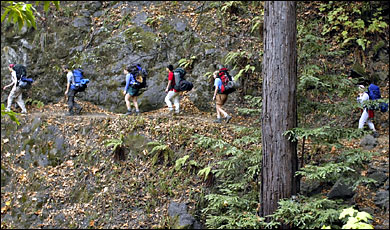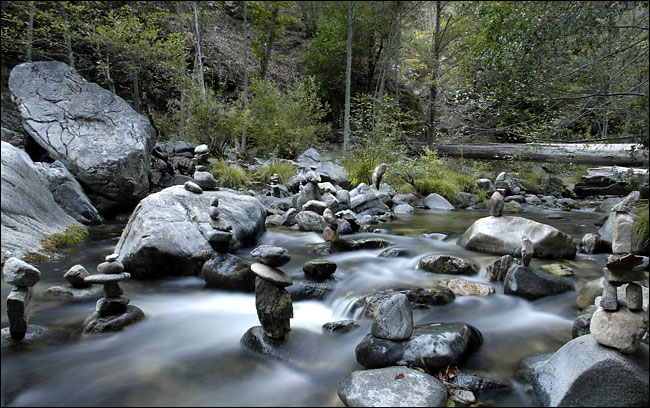November 19, 2004
JOURNEYS
A Soak at the End of the Trail
By BONNIE TSUI
IF you talk to any California hiker about hot springs, chances are Big Sur will come up in the conversation. And there's no more quintessential California hot springs hike than the trail to the fern-banked soak called Sykes, through groves of 300-foot-tall redwoods and the steep chaparral-covered slopes of the Ventana Wilderness, south of Monterey.
 Almost every trekker in the area makes a pilgrimage to Sykes Hot Springs at some point, and for good reason. The springs are relatively accessible — 10 miles each way from a ranger station off Highway 1 — and doable as a weekend trip, with an overnight at the Sykes campground, run by the National Forest Service. At the same time, the terrain is challenging, with plenty of up and down, and rich in variety. Because Big Sur country straddles the border between northern and southern California, it is characterized by quick changes over short distances — from the north's trademark redwoods and oaks to the yucca and dry scrub typical of the south.
Almost every trekker in the area makes a pilgrimage to Sykes Hot Springs at some point, and for good reason. The springs are relatively accessible — 10 miles each way from a ranger station off Highway 1 — and doable as a weekend trip, with an overnight at the Sykes campground, run by the National Forest Service. At the same time, the terrain is challenging, with plenty of up and down, and rich in variety. Because Big Sur country straddles the border between northern and southern California, it is characterized by quick changes over short distances — from the north's trademark redwoods and oaks to the yucca and dry scrub typical of the south. At the end of the trek the hiker finds the cool waters of the Big Sur River running alongside the 100-degree pool of Sykes Hot Springs, boulder-lined and large enough to fit about six people. Depending on the water flow, other smaller pools can sometimes be found between it and the river, marked by cairns that previous visitors have left behind.
"There's nothing quite like sitting in a natural hot pool next to a cold brook or river," said Michael Elliott, 30, of Half Moon Bay, Calif., a biochemist and a seasoned hiker who has made the trip up to Sykes.
Timing matters, and the season for enjoying the Sykes springs to their fullest is now, in autumn, when the crowds thin out. During peak season, from April to early September, the number of visitors on weekends can reach the triple digits.
When things are that crowded, Mr. Elliott said, "you tend to deal with a wide variety of people — families who might be reluctant to accept those who want to be in their birthday suits, or folks who take little heed to the concept of quiet serenity."
Manuel Madrigal, a recreation officer for the Monterey Ranger District, which oversees the Ventana Wilderness, offers a similar warning. "We're trying to discourage people from going to Sykes during the high season, because it's getting so popular and it's a small site," he said.
The Pine Ridge trailhead, where the hike to Sykes Camp and the springs begins, is behind the parking lot at the Big Sur Forest Service station, three miles south of the town of Big Sur. The Pine Ridge corridor goes up 10 miles to Sykes and then 14 miles beyond, linking with numerous other trails on the way.
On the first section of the hike to the hot springs, within Pfeiffer Big Sur State Park, coastal redwoods tower overhead as the trail quickly rises from the traffic on Highway 1. It's tough going on the initial uphill section, but there's plenty to see: tiny lizards scamper over boulders, blue jays dart through twisting manzanita trees, and the blue swell of the Pacific can be spotted in the distance as the narrow trail climbs high on a ridge above the canyons.
The route turns east and heads deep into the Ventana Wilderness, 239,110 acres of the Los Padres National Forest blanketing the coastal Santa Lucia Mountains. The trail makes numerous ascents to dry exposed ridgelines and plunges down to shaded stream crossings, with swimming-hole detours for those who want a cold dip on the way to the hot one.
Finally, tired hikers reach the Big Sur River, the Sykes campground and the springs, which lie several hundred yards downstream. (Detailed directions are available from the information desk at the Forest Service station.)
Stone-lined tubs are terraced above the riverbank, the largest about 10 feet across and flanked by a large boulder. Though the pools are natural — the water has a slightly sulfurous odor — their walls are often shored up by hikers and soakers, using rocks and sand.
The valley surrounding the hot springs and the Big Sur River is deep and covered by dense forest, increasing the sense of blissful isolation. When the sun begins to set, particularly in autumn, the air cools sharply, which makes the hot water even more of a trail's-end treat for sore muscles and tired feet.
HOT springs are Mother Nature's rendition of a spa," said Stephanie Pearson, a senior editor at Outside magazine. "Plus, they're so few and far between that coming across one at the end of a long hike feels like striking gold. That said, it's best to find one that doesn't already have 50 naked bodies merrily soaking away in it."
Although this spot feels suitably hidden, much of the West Coast's geothermal activity is in places that are far more remote: mountainous areas along the earthquake and volcano belts in Oregon, Washington, the High Sierra in Northern California and the high desert in Southern California.
Sykes's accessibility, particularly from the San Francisco Bay Area, and the prevailing interest in all things healthy combine to make the Pine Ridge corridor a regional favorite.
"The hot springs here got really popular around the 60's, when the hippie era started," said Mr. Madrigal, the recreation officer. "Before that, only the local people knew about it, and it didn't see so many visitors. Now we're into the health craze era, where people take longer hikes, and it's becoming extremely popular again."
Diederik Marius, president of the Redwood Club at Stanford University, leads outdoor trips every weekend for students. "Every quarter we have one or two trips up to Sykes," he said. "It's a place you can go all year round. Lots of people don't like hiking or camping in the snow, and the springs are a really good alternative. It's a romantic thought: hike all day, set up camp, and then go relax in one of the hot springs under the stars."
The only drawback, he added, is that a lot of people expect the Sykes hot pools to be bigger than they are.
A lot of locals would prefer to keep Sykes Hot Springs under wraps. On a recent visit, there were no signs marking the Sykes campground or the springs, odd for the Pine Ridge Trail, which is extremely well marked at every other turn and camp site.
"Signs get taken down a lot," said Eli Curley, a park aide at the Big Sur Forest Service station. "It's a continuing problem, but it's a special place to a lot of people. They don't want other folks to know where it is."
CALIFORNIA
Sykes Hot Springs, Ventana Wilderness, Los Padres National Forest.
Pick up a free back-country fire permit and directions at the National Forest Service's Big Sur Station (Highway 1, Big Sur, Calif.; 831-667-2315), or get a permit online at www.fs.fed.us/r5/lospadres. Overnight parking at the station is $4 a day. A guidebook, especially useful because area maps are out of print, is "Hiking the Big Sur Country: The Ventana Wilderness" by Jeffrey P. Schaffer (Wilderness Press, 1988). Information: Monterey Ranger District, (831) 385-5434.
